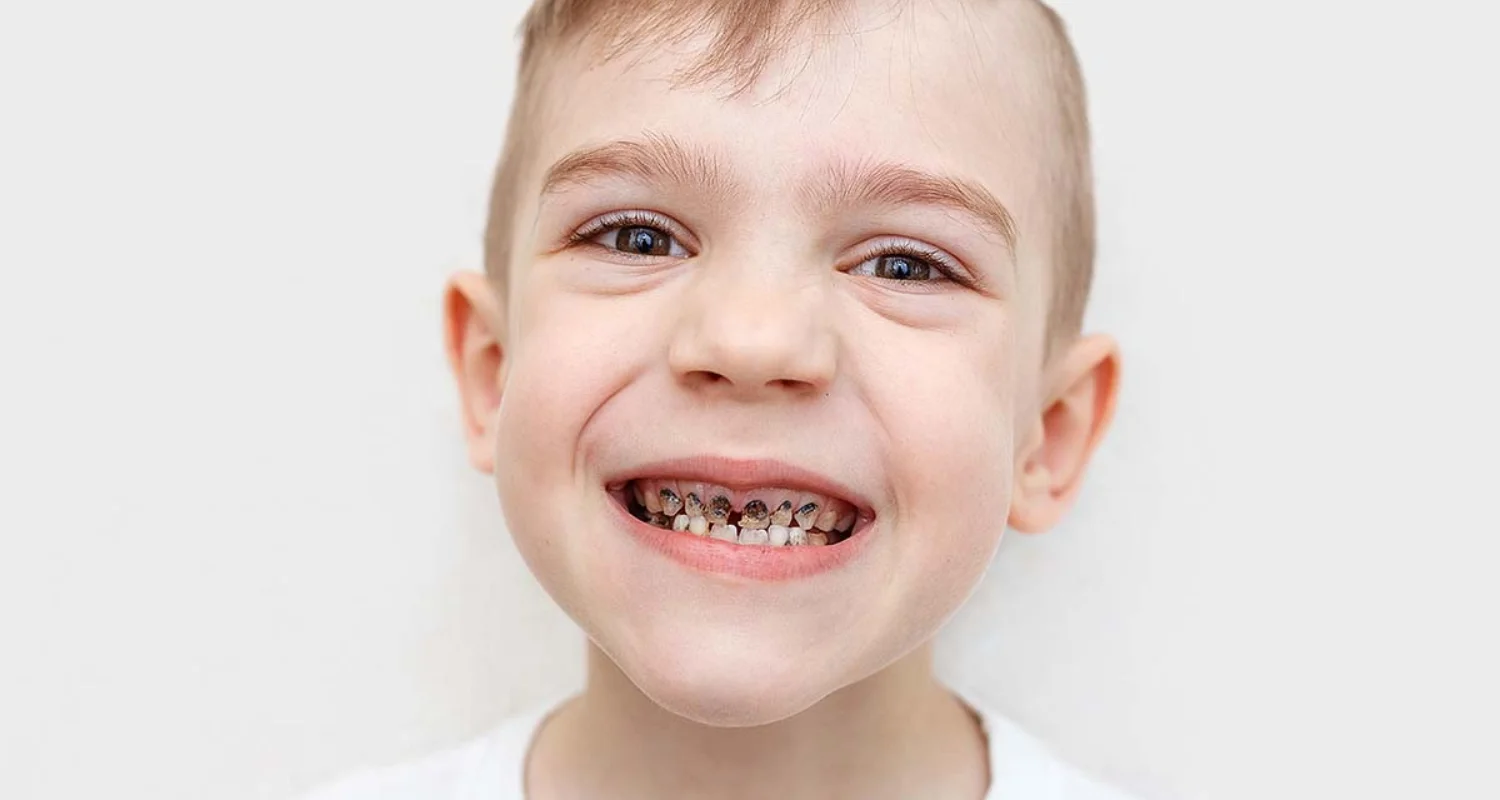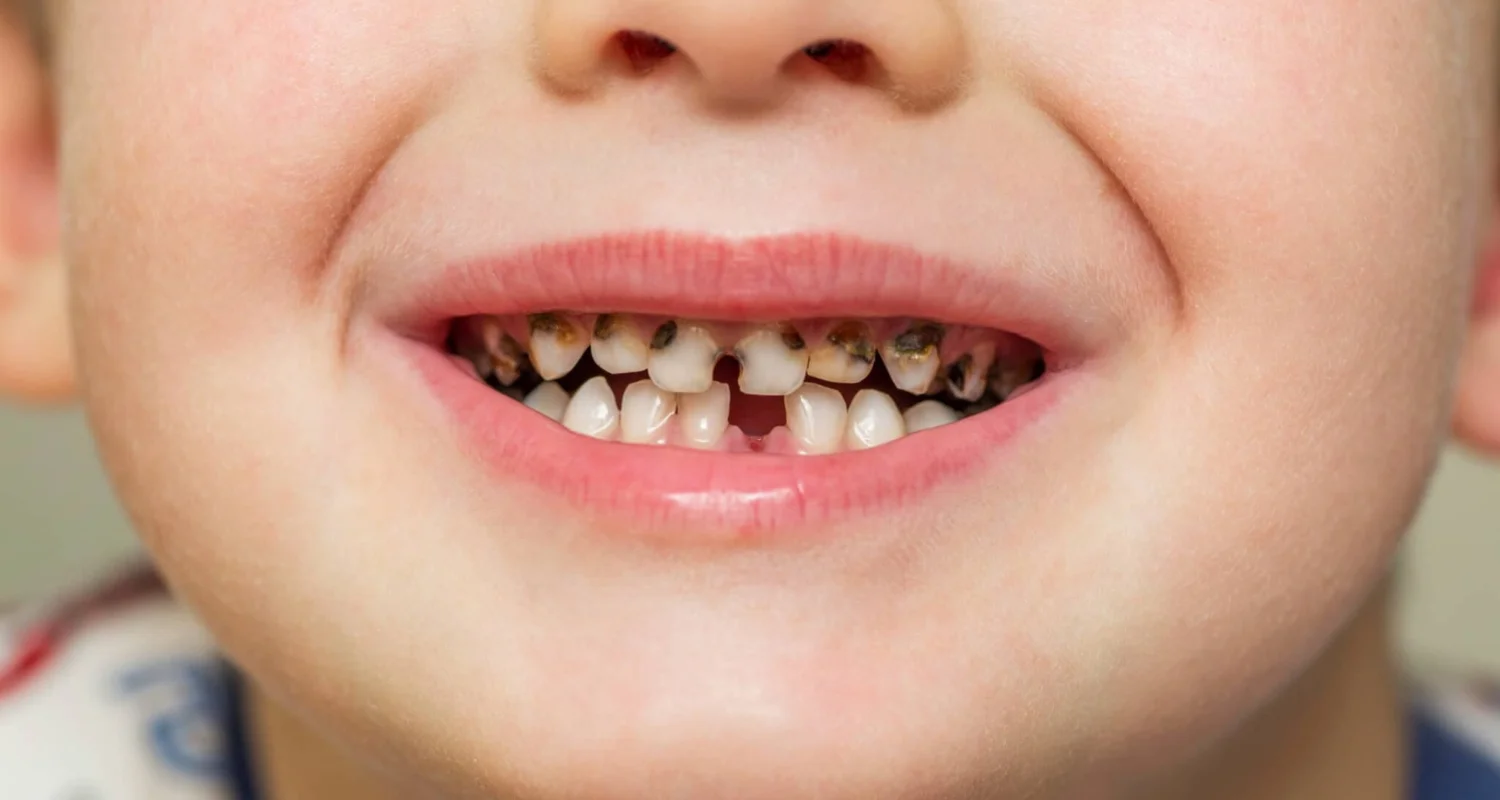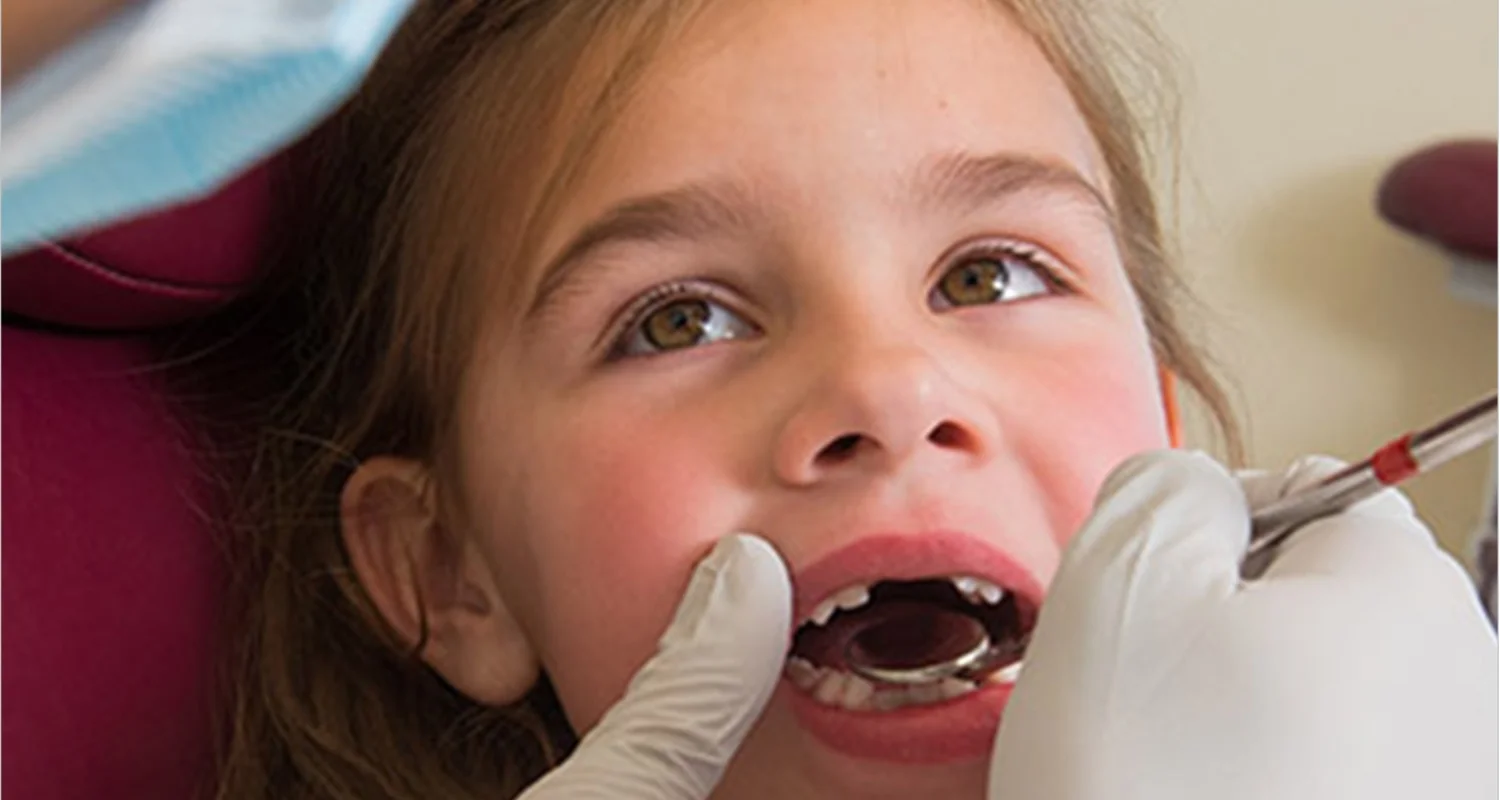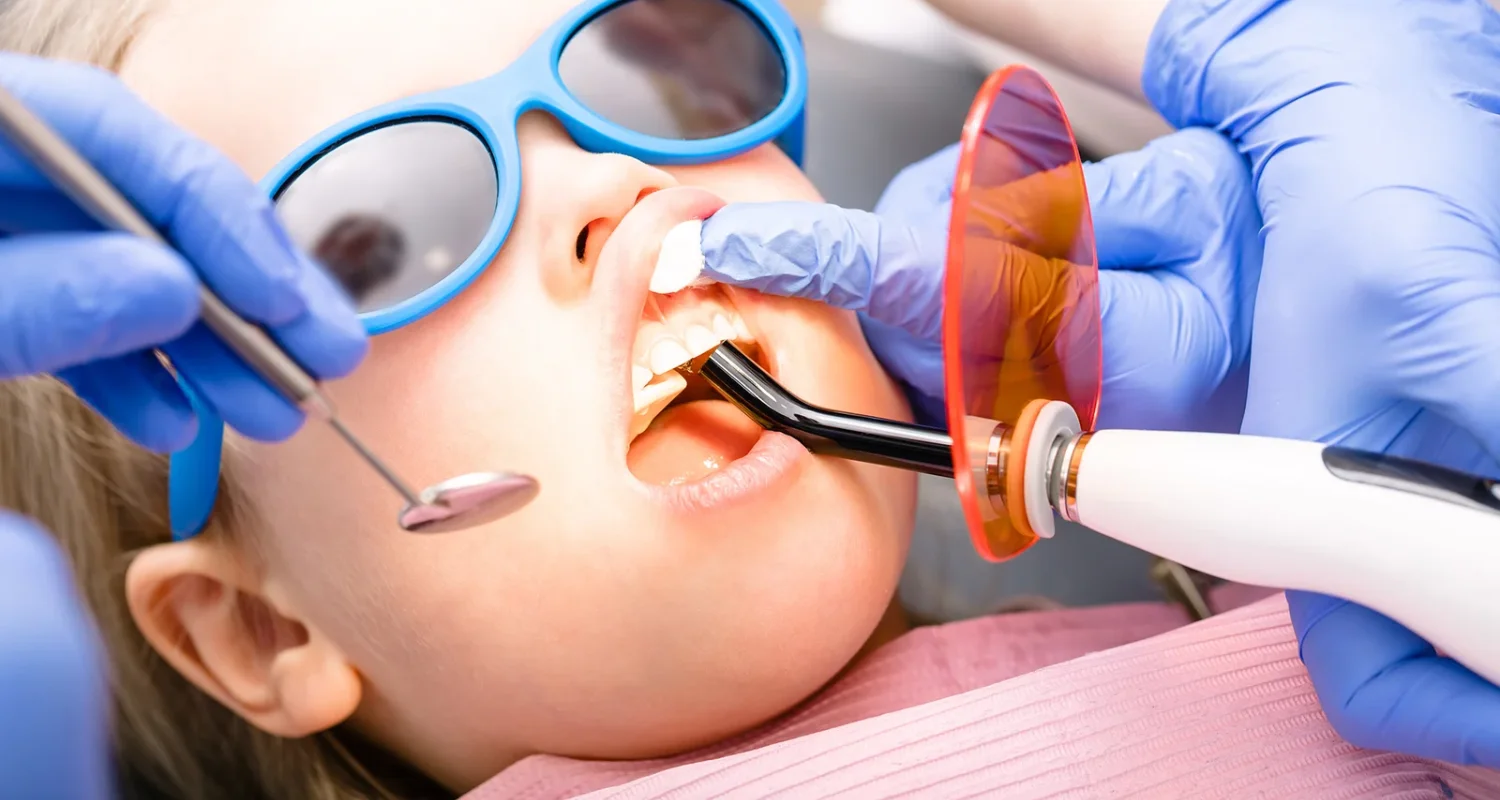Last Updated on: 19th September 2025, 12:37 pm
Did you know why early childhood caries are a common problem in kids?
Dental care is essential for overall well-being, regardless of one’s age, but it is especially important for children. Developing good oral hygiene habits early on helps prevent problems like tooth decay, gum disease, and even speech or eating difficulties.
Children, due to their preference for sugary foods, are particularly vulnerable to tooth decay. This condition, known as early childhood caries, is a significant health issue affecting the oral health of many infants and young children today.
Did you know that dental caries in children are five times more common than asthma and seven times more common than hay fever? While the prevalence of caries has declined in permanent teeth, decay in primary teeth is rising by the hour.
Nearly 40% of children experience dental caries by the age of five, and about 8% of two-year-olds show signs of decay or have had dental restorations. A matter of concern, isn’t it?
In this article, we will explore early childhood caries, the associated risk factors, and simple tips and strategies to prevent this condition effectively.
What are early childhood caries?
Early childhood caries (ECC), formerly known as nursing bottle caries, rampant caries, or baby bottle caries, are defined as the presence of one or more decayed, missing, or filled tooth surfaces in any primary tooth in a child at 71 months of age or younger.
It has several unique characteristics such as rapid development and may affect a number of teeth soon after they emerge in the oral cavity. These cavities can appear on tooth surfaces that are usually less vulnerable to decay.
The World Health Organization (WHO) recognizes early childhood caries as a global issue, with prevalence rates between 60% and 90%, highlighting the urgency for timely intervention.
Early Childhood Caries: Risk Factors and Causes
Wondering what are the various causes and risk factors for early childhood dental caries?
Well, keep reading to learn more!
Cariogenic microorganisms
The main bacteria responsible for early childhood caries are Streptococcus mutans and Streptococcus sobrinus, with Lactobacilli aiding in the progression. These bacteria metabolize sugars to produce lactic acid, which lowers oral pH and leads to enamel demineralization, eventually causing tooth decay.
Transmission of infection
Streptococcus mutans is transmitted from mother to child through saliva, food, or utensils (vertical transmission). Cesarean births increase caries risk due to a more sterile environment. Horizontal transmission can occur among siblings and caregivers.
Dietary and feeding practices
Improper feeding practices, such as sugary food consumption, falling asleep with a bottle, and prolonged nighttime breastfeeding after 12 months, increase the risk of caries. Bottle sipping during the day also contributes to this risk.
Sugary diet
Frequent consumption of sugary drinks and foods, especially before sleep, increases caries risk due to reduced salivary flow at night.
Developmental enamel defects
Conditions like enamel hypoplasia increase the likelihood of caries as rough enamel surfaces attract bacteria.
Systemic diseases and medications
Children with diabetes, special needs, or undergoing radiotherapy (using sugary lozenges) are more prone to caries due to higher sugar levels or difficulty maintaining oral hygiene.
Socioeconomic and ethnic factors
Caries are more prevalent in children from low socioeconomic backgrounds, linked to malnutrition, poor oral hygiene,a lack of dental care, and fluoride exposure.
Why is it Important to Prevent Early Childhood Caries?
Preventing early childhood caries is crucial because untreated dental caries can lead to long-term health issues, such as:
● Pain and sensitivity: Cavities start in the tooth’s enamel; once they reach the dentin, cause sensitivity and pain. If the cavity reaches the tooth’s pulp, the pain can become severe, affecting sleep.
● Premature tooth loss: This can cause long-term issues like crooked teeth, bite problems, and difficulties with eating and speaking.
● Serious infections: If untreated, cavities can cause painful dental pulp infections, which may spread to other parts of the body and cause infections such as Ludwig’s angina and a brain abscess in severe cases.
Left untreated, cavities can damage permanent teeth and affect overall oral health, leading to more complex dental issues later in life.
Essential tips to prevent childhood dental caries
Below are a few tips and strategies to help prevent early childhood caries:
● Establish a routine: Create a consistent oral hygiene routine that includes brushing twice a day and flossing once daily, preferably with fluoridated toothpaste depending on your child’s age. Inculcating healthy brushing habits early on goes a long way.
● Limit sugary foods and drinks: Reduce the intake of sweets, sugary snacks, and beverages. Encourage healthier alternatives like fruits, vegetables, and dairy products, rich in fiber, vitamins, and minerals.
● One can use calcium and fluoride supplements under the guidance of a healthcare professional.
● Promote water consumption: Encourage children to drink plenty of water, especially fluoridated water, to rinse away food particles and strengthen teeth.
● Avoid bedtime bottles: Do not allow children to go to bed with bottles containing milk or juice to prevent prolonged exposure to sugars.
● Regular dental checkups: Schedule regular dental visits for professional cleanings and checkups to monitor oral health and catch potential issues early.
● Educate about oral hygiene: Teaching children the importance of oral health and encouraging them to take an active part in their dental care is essential.
● Lead by example: Demonstrate good oral hygiene habits yourself to encourage children to follow suit.
What Parents and Caregivers Can Do About Early Childhood Caries
For babies:
● Gum care: Wipe your baby’s gums twice daily using a soft, clean cloth after the first feeding in the morning and right before bedtime to remove bacteria and sugars that may cause cavities.
● Tooth care: Once teeth emerge, begin brushing them twice a day with a small, soft-bristled toothbrush and plain water.
● Dental visits: Schedule a dental appointment by your baby’s first birthday to catch any potential issues early.
● Fluoride varnish: Discuss with your dentist or doctor the possibility of applying fluoride varnish on your child’s teeth as soon as the first tooth appears.
For children:
● Brushing routine: Brush your child’s teeth twice daily with fluoride toothpaste. Consider using an electric toothbrush with built-in timers or app connectivity; they are available in fun designs to make brushing more enjoyable. Consult your dentist for recommendations.
● Supervise brushing: Assist your child until they develop proper brushing skills. For children under 6, supervise their brushing to ensure they use a pea-sized amount of toothpaste and spit it out rather than swallow.
● Pit and fissure sealants: Ask your child’s dentist about applying dental sealants when appropriate to protect against cavities.
● Fluoridated water: Encourage drinking tap water that contains fluoride to strengthen teeth and reduce cavity risk.
Early childhood caries is a preventable condition that can have serious long-term consequences if left untreated. By fostering good oral hygiene habits, limiting sugary foods, encouraging water consumption, and scheduling regular dental checkups, parents and caregivers can significantly reduce the risk of cavities in children.
Conclusion
Thank you for reading! We hope these tips help you protect your child’s smile from early childhood cavities. Remember, starting good dental habits early makes a world of difference in your child’s overall health. For more detailed information on preventing cavities and other oral health topics, explore our other articles. Together, let’s keep those little smiles shining bright!”
Frequently Asked Questions
What are the contributing factors for early tooth decay in toddlers?
Early tooth decay in toddlers, also known as early childhood caries, can be attributed to several factors. One of the primary contributors is poor dietary habits, particularly frequent consumption of sugary foods and drinks, such as juice or sweetened milk. When sugar remains on the teeth, it encourages the growth of harmful bacteria that produce acid, leading to enamel erosion and cavities. In addition, improper oral hygiene, such as not brushing regularly or thoroughly, contributes to the problem.
Another key factor is the use of bottles or sippy cups filled with sugary liquids, especially when toddlers are allowed to sip on them throughout the day or take them to bed. Prolonged exposure to sugar leads to a higher risk of decay. Genetics can also play a role, as some children may be more predisposed to developing cavities due to weaker enamel or other inherited dental issues.
What is the cause of a baby's tooth decay before two years?
Tooth decay in babies before the age of two, commonly referred to as baby bottle tooth decay, often occurs due to prolonged exposure to sugary liquids. This can happen when a baby is regularly put to bed with a bottle containing milk, formula, or juice. The sugars in these liquids remain in the mouth for extended periods, feeding bacteria that produce acids, which attack the enamel of the teeth.
In some cases, bacteria responsible for tooth decay, such as Streptococcus mutans, can be transmitted from caregivers to the baby through shared utensils or close contact. This bacteria thrives in the presence of sugars, making the baby more susceptible to decay if proper oral hygiene is not maintained, even before they turn two.
How serious is baby bottle tooth decay?
Baby bottle tooth decay is a serious condition that can have long-term consequences if left untreated. In its early stages, it may cause pain and sensitivity in the teeth, but as the decay progresses, it can lead to more severe issues. Cavities may worsen, leading to infection in the dental pulp, which can cause abscesses and pain that can affect the baby’s eating, sleeping, and overall well-being.
In extreme cases, untreated tooth decay can result in the premature loss of baby teeth, which can affect a child’s speech development, ability to chew properly, and even cause misalignment in permanent teeth as they grow in. Additionally, severe decay can spread to other parts of the body, causing more serious infections. Therefore, it is critical to address baby bottle tooth decay as soon as signs appear.
How to treat dental caries in children?
Treating dental caries in children involves several approaches, depending on the severity of the condition. For early-stage cavities, fluoride treatments can help to remineralize and strengthen the teeth, potentially reversing the damage. In some cases, dentists may apply sealants to protect vulnerable teeth from further decay.
For more advanced cavities, treatment often involves filling the cavities with dental materials like composite resin. If the decay has reached the tooth pulp, more extensive procedures like root canals may be necessary to save the tooth. In severe cases where the tooth is beyond repair, extraction may be required. Regular dental checkups and proper at-home care, such as brushing with fluoride toothpaste and flossing, are essential in managing and preventing future caries.
What are the common issues of dental health in children?
Common dental health issues in children include cavities (tooth decay), gum disease (gingivitis), and malocclusion (misaligned teeth). Cavities are the most prevalent, often caused by poor oral hygiene and a diet high in sugars. Gum disease in children can occur due to inadequate brushing, allowing plaque to build up and irritate the gums, causing inflammation and bleeding.
Other issues include enamel defects, such as hypoplasia, which makes the teeth more prone to decay, and early tooth loss, which can affect the development of permanent teeth. Dental injuries from accidents are also common in active children. Regular dental visits can help catch and address these issues before they become more severe.
Why do children often face cavities?
Children often face cavities because they are more likely to consume sugary foods and drinks, which provide a breeding ground for bacteria that cause tooth decay. Young children may also struggle with maintaining consistent oral hygiene habits, such as brushing and flossing regularly, which allows plaque to build up and damage their teeth.
Additionally, children’s enamel, especially in baby teeth, is thinner and less resistant to decay than adult enamel, making their teeth more susceptible. Many children also lack access to fluoride, which strengthens enamel and helps prevent cavities, especially if they drink non-fluoridated water or do not use fluoride toothpaste. Proper dental care and dietary habits can significantly reduce the risk of cavities in children.
Share
References
1. Oral Health Tips for Children. (2024, May 15). Oral Health. https://www.cdc.gov/oral-health/prevention/oral-health-tips-for-children.html
2. Tungare S, Paranjpe AG. Early Childhood Caries. [Updated 2023 Aug 8]. In: StatPearls [Internet]. Treasure Island (FL): StatPearls Publishing; 2024 Jan-. Available from: https://www.ncbi.nlm.nih.gov/books/NBK535349/
3. Kazeminia, M., Abdi, A., Shohaimi, S. et al. Dental caries in primary and permanent teeth in children’s worldwide, 1995 to 2019: a systematic review and meta-analysis. Head Face Med 16, 22 (2020). https://doi.org/10.1186/s13005-020-00237-z
4. Anil, S., & Anand, P. S. (2017). Early Childhood Caries: Prevalence, Risk Factors, and Prevention. Frontiers in pediatrics, 5, 157. https://doi.org/10.3389/fped.2017.00157
5. Rdh, D. M. M. P. (2024, May 17). Tackling Early Childhood Caries. Decisions in Dentistry. https://decisionsindentistry.com/article/tackling-early-childhood-caries/#:~:text=Early%20childhood%20caries%20(ECC)%20is,children%20ages%206%20and%20younger
-
Nayibe Cubillos M. [Author]
Pharmaceutical Chemestry |Pharmaceutical Process Management | Pharmaceutical Care | Pharmaceutical Services Audit | Pharmaceutical Services Process Consulting | Content Project Manager | SEO Knowledge | Content Writer | Leadership | Scrum Master
View all posts
A healthcare writer with a solid background in pharmaceutical chemistry and a thorough understanding of Colombian regulatory processes and comprehensive sector management, she has significant experience coordinating and leading multidisciplina...





















